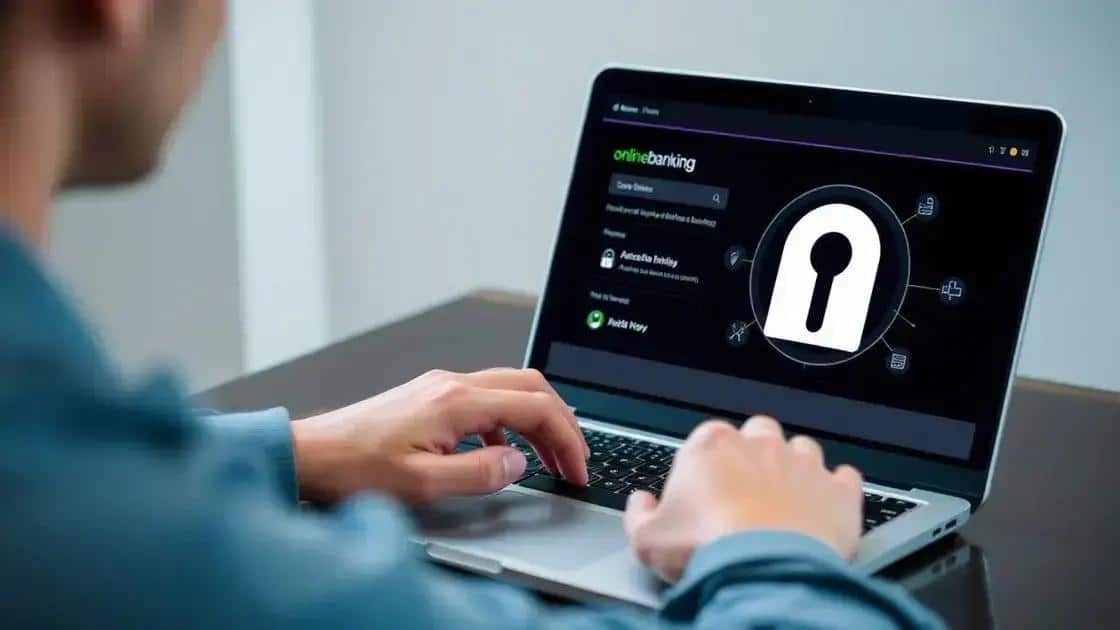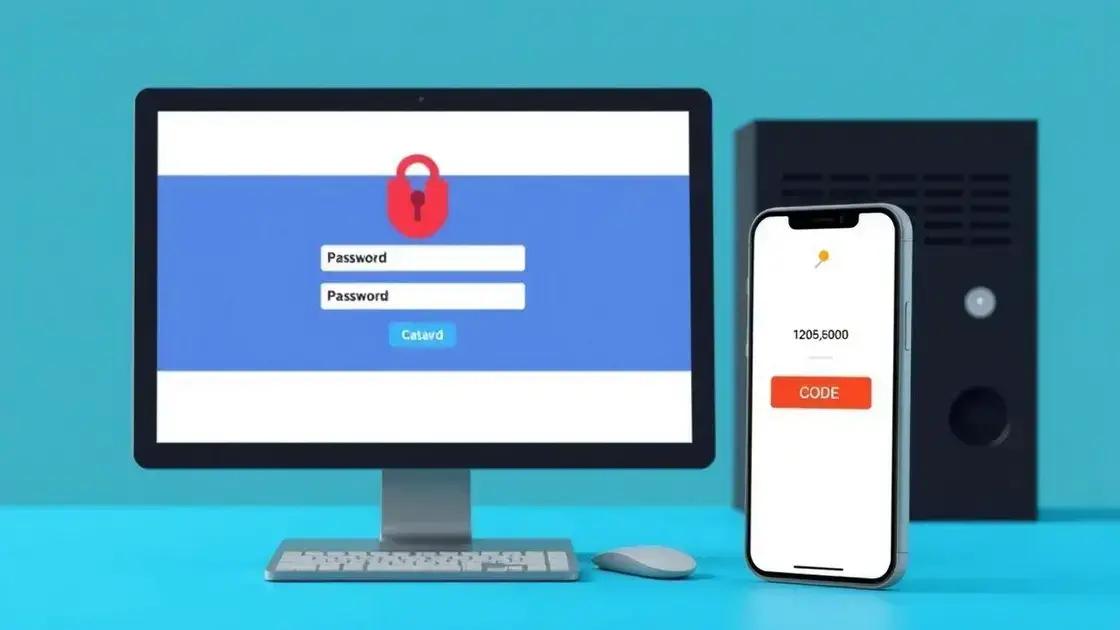Beautiful online banking safety tips for a secure experience

Online banking safety is crucial; use strong passwords, enable two-factor authentication, verify HTTPS websites, and monitor your accounts regularly to protect against threats like phishing and malware.
Beautiful online banking safety is crucial for anyone engaging in digital financial transactions. Have you ever wondered how secure your online banking really is? Let’s dive into the key aspects that keep your money safe.
Understanding the importance of online banking security
Understanding online banking security is vital for everyone who manages their finances digitally. Many people might overlook this important aspect until they face an issue. The truth is, ensuring your financial safety online is easier than you think.
Why Security Matters
When we talk about online banking security, we are referring to the measures taken to protect your account from unauthorized access. This is crucial because any breach can lead to significant financial losses. It’s important to realize that your personal information could be targeted by cybercriminals.
Common Risks
- Phishing attacks often trick customers into providing personal information.
- Malware can infect your device, monitoring your online activities.
- Weak passwords make it easier for hackers to access your accounts.
Online banking safety is not just about technology; it’s also about being aware of your habits. Simple actions, like regularly updating your passwords and monitoring your statements, can go a long way in preventing fraud.
Always ensure that you are using secure websites. Look for HTTPS in the webpage URL, which indicates that the connection is encrypted. Additionally, using a Virtual Private Network (VPN) while banking on public Wi-Fi adds another layer of protection. Remember, the safer your online activities are, the more you can enjoy banking from the comfort of your home without worry.
Common threats to online banking safety
Common threats to online banking safety can put your finances at risk if you are not aware of them. Knowing these threats is the first step towards protecting yourself. Many users don’t realize how vulnerable they are when banking online.
Phishing Attacks
One of the biggest threats is phishing. Cybercriminals often send emails that look like they are from your bank. These emails can trick you into providing personal information, like your passwords. Always check the sender’s email address and avoid clicking on suspicious links.
Malware
Another serious threat is malware. This software can infect your device without your knowledge. It may log your keystrokes, capturing your login information. Running a good antivirus program helps to prevent these infections.
- Ensure your antivirus software is updated regularly.
- Avoid downloading unknown files or applications.
- Keep your operating system up to date to fix security holes.
Moreover, using public Wi-Fi can expose you to risks. Hackers can intercept your information if you access your online bank account on an unsecured network. It’s safer to use mobile data or a secure home Wi-Fi connection.
Weak passwords are another major threat. Many people use simple passwords that are easy for hackers to guess. A strong password, along with two-factor authentication, makes it harder for unauthorized users to access your account. Use a mix of letters, numbers, and symbols to create a robust password.
Best practices for protecting your online bank account

Implementing best practices for protecting your online bank account is essential for your financial security. With increasing cyber threats, it’s crucial to take proactive steps to safeguard your information.
Create Strong Passwords
One of the first lines of defense is your password. Use a combination of upper and lower case letters, numbers, and special characters. A strong password should be at least 12 characters long. Change your passwords regularly and never reuse them across different sites.
Enable Two-Factor Authentication
Two-factor authentication (2FA) adds an extra layer of security to your accounts. When logging in, you will need to enter a code sent to your phone or email. This means that even if someone gets your password, they won’t be able to access your account without your second factor.
- Set up recovery options for your accounts.
- Regularly monitor your account statements for unusual activities.
- Be cautious of security questions; choose answers that are not easily guessed.
It’s also critical to keep your devices secure. Ensure that your computer has updated antivirus software and a firewall. Be wary of using public Wi-Fi for banking transactions, as these networks are often not secure.
Regularly reviewing your financial statements helps in spotting unauthorized transactions early on. Contact your bank immediately if you notice anything suspicious.
Lastly, remember to log out of your bank account after each session, especially if you are on a shared or public computer. Simple habits like these significantly enhance your overall online banking safety.
How to identify secure banking websites
Knowing how to identify secure banking websites is an essential skill for anyone managing their finances online. With the rise of cybercrime, recognizing safe sites can protect your personal information.
Look for HTTPS
One of the first things to check is the URL of the website. A secure site will start with HTTPS, where the ‘S’ stands for secure. This means any data sent between your browser and the website is encrypted, making it harder for hackers to intercept.
Check for a Padlock Icon
Next, look for a padlock icon in the address bar. This symbol indicates that the website is secure. If you click on the padlock, you can view the site’s security certificate details, which confirm the identity of the site.
- Ensure the certificate is still valid.
- Verify that the certificate is issued by a trusted certificate authority.
- Be skeptical of sites that do not display a padlock.
Additionally, reputable banking sites will have clear contact information and customer support options. If a site lacks transparency in these areas, it may be a red flag.
Be cautious of sites with poor design or numerous pop-up ads. Legitimate banking websites typically maintain a professional layout and user-friendly experience. Remember to also read reviews and check if other users have faced issues with the site.
Before logging in, take a moment to review your browser’s security settings. Keep your software up to date, which helps safeguard against potential threats while using online banking.
The role of two-factor authentication in online banking
The role of two-factor authentication (2FA) in online banking is crucial for enhancing security. It is a method that adds an extra layer of protection beyond just a password.
How 2FA Works
When you log into your online bank account, after entering your password, you will receive a second prompt. This prompt might ask for a code sent to your phone or email. This ensures that even if someone obtains your password, they cannot access your account without the second code.
Why It’s Important
Using 2FA greatly reduces the chances of unauthorized access to your account. Many cybercriminals try to steal passwords through phishing. Even with a strong password, if it is compromised, 2FA acts as a barrier.
- It protects against common threats like keyloggers and phishing attempts.
- 2FA alerts you to any login attempts from unknown devices.
- Most banks offer 2FA, and it’s a simple process to set up.
Implementing two-factor authentication is easy and wise. Every time you log in, you know that an additional step is keeping your financial information safe. Some banks even allow you to choose between different methods for receiving your codes, such as text messages, authentication apps, or email.
Even though 2FA adds a few seconds to the login process, the security benefits far outweigh the inconvenience. It’s a simple yet effective way to protect your assets online.
In conclusion, protecting yourself while online banking is essential in today’s digital world. Understanding the importance of online banking security and recognizing potential threats can help keep your financial information safe. Implementing strong passwords, enabling two-factor authentication, and knowing how to identify secure banking websites are critical steps in your defense. By following these best practices, you can enjoy a safe and secure online banking experience.
FAQ – Frequently Asked Questions about Online Banking Safety
What is two-factor authentication and why is it important?
Two-factor authentication adds an extra layer of security by requiring a second form of verification, making it harder for unauthorized users to access your account.
How can I identify a secure banking website?
Look for URLs that start with ‘HTTPS’ and check for a padlock icon in the address bar to ensure a secure connection.
What common threats should I be aware of when banking online?
Common threats include phishing attacks, malware, and weak passwords. Being aware of these can help protect your accounts.
Why should I regularly monitor my bank statements?
Regular monitoring helps you quickly identify unauthorized transactions, allowing you to act promptly to prevent further fraud.






